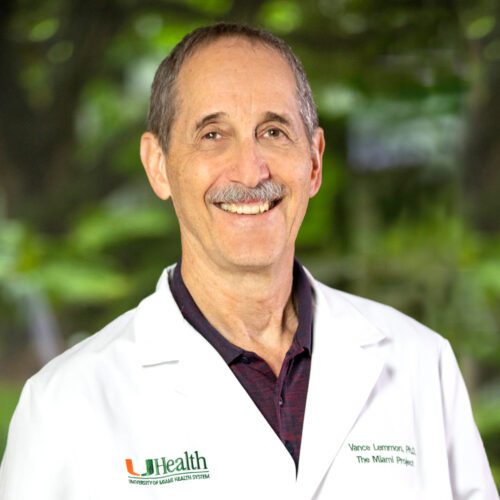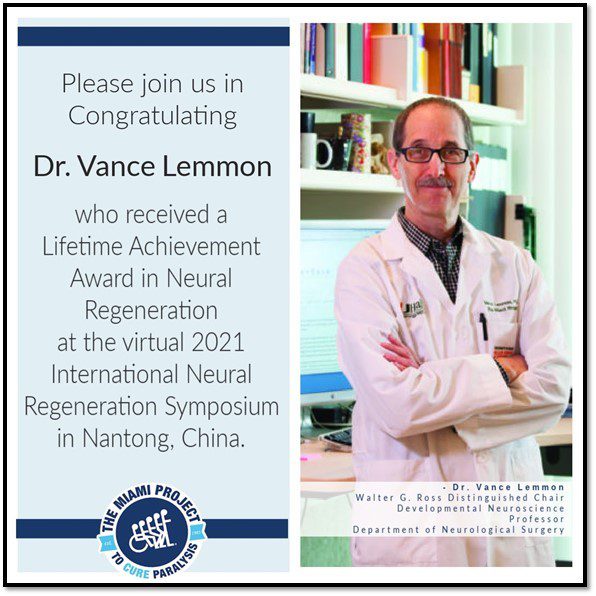Vance Lemmon, Ph.D.
Walter G. Ross Distinguished Chair in Developmental Neuroscience
Professor, Department of Neurological Surgery

The Miami Project to Cure Paralysis
1095 NW 14th Terrace (R-48)
Miami, FL 33136
Research Interests
Areas Of Research
Publications
More
High Content Screening and Functional Genomics of the Nervous System
In 2003 I merged labs with John Bixby, and we began to use various strategies, especially phenotypic screening, to hunt of targets or perturbagens (compounds, drugs, cDNAs, siRNAs, etc) that could help improve axon regeneration after injury to the mammalian CNS.
We have pursued 5 large projects over the past 20 years: 1) genes differentially expressed between the PNS and CNS (PNS can regenerate axons; the CNS? Not so much), 2) developmentally regulated genes (the immature CNS can regenerate axons but the adult CNS can’t), 3) genes differentially expressed in the PNS after a conditioning lesion, which enhances axon regeneration, 4) a crazy, large screen of millions of compounds, and last but not least 5) Kinases – they regulate virtually all biological processes and represent a target rich family of genes with thousands of kinase inhibitors that can be used to explore this biological space.
The first project springs from the fact that neurons in the peripheral nervous system can regenerate axons while neurons in the central nervous system (CNS) are not. By analyzing data from several molecular biological approaches, including RNA-seq, we were able to identify genes that are differentially expressed in regenerating peripheral neurons; of particular interest is a set of transcription factors (TFs) that are likely to regulate expression of other genes. We have focused on Stat3 for several years and have shown that by fusing it to a viral activation domain, we can substantially boost axon regeneration of optic nerve axons and sprouting of CST axons (Exp Neurol. 2016 PMID: 27060489).
Our second project is based on the fact that young CNS neurons have a greater regenerative capacity than old CNS neurons (collaboration with Dr. Murray Blackmore and Dr. Jeff Goldberg). We used DNA microarray data to generate a list of 800 candidate genes. We tested genes on our list in our High Content Screening platform and identified KLF transcription factors as key regulators of axon regeneration in the mammalian CNS (Science. 2009 PMID: 19815778, Mol Cell Neurosci. 2010 PMID: 20159039, Proc Natl Acad Sci U S A. 2012 PMID: 22529377).
The conditioning lesion paradigm was the basis for a fun collaboration with the Simon DiGiovanni lab (Science, Nat Communications, Nature Neuroscience, EMBO J, Sci Trans Med, Nat Cell Biology). Thank you to the amazing Matt Danzi (17 co-authored papers – crazy). Did you know exercise is really good for you (PMID: 30971452)?
If you want to pretend you are big pharma – screen clever pools of compounds with the people at Torrey Pines Research Institute (now part of FIU). Our team, led by Hassan Ali, identified some compounds that promote neurite growth in vitro. We are studying them in vivo now, thanks to support from the Craig H. Neilsen Foundation.
The last project involves Kinase Inhibitors (KIs) to promote control axon regeneration. This project with Dr. Hassan Ali, uses clever information and artificial intelligence algorithms to both identify kinases that should be inhibited and kinases that must be avoided to stimulate axon regeneration. We screened over 1600 KIs and found a number that have very large effects in vitro. One, RO48, has shown strong axon regeneration and sprouting effects in vivo and is serving as a basis for a medicinal chemistry program. The in vivo experiments are being done with Jae Lee at The Miami Project and Xiao-Ming Xu, at Indiana University (ACS Chem Biol. 2015 PMID: 26056718, Assay Drug Dev Technol. 2015 PMID: 26230074, J Neurosci. 2017 PMID: 28626016, Exp Neurol. 2022 PMID: 35588791). Due to strong preliminary data, we got a Blueprint Neurotherapeutics Network (BPN) project to turn RO48 into a drug for SCI. It does not get any cooler than that.
All of our high throughput experiments have had the unintended consequence of our lab becoming involved in various informatics and reporting standards projects done with Stephan Schürer, Nigam Shah, Alison Callahan, Adam Ferguson and Karim Fouad (PMID: 21471461, PMID: 21702939, PMID: 24870067, PMID: 2705582, PMID: 28576567, PMID: 31608767 and others)
Key technologies: High Content Analysis, deep sequencing & informatics, tissue clearing, fluorescent light sheet microscopy / ultramicroscopy
Visit Dr. Lemmon’s Publication Listing
News Stories
Dr. Vance Lemmon Awarded the Lifetime Achievement Award in Neural Regeneration (May 2022)
NIH/NINDS Blueprint Neurotherapeutics Network Grant (April 2022)
On the Edge of Discovery (December 2019)
Understanding the Challenges of Re-connecting Neurons after Spinal Cord Injury (October 2019)
Turbo Charging Discovery with High-Content Screening (September 2019)
Replication Studies and The Miami Project (July 2019)
Miami Project Researchers Launch Startup Truvitech (March 2018)
Industry and Academia: Drs. John Bixby, Vance Lemmon and Hassan Al-Ali (October 2016)
Miami Project Receives NIH Grant to Study Axon Regeneration (September 2016)
Research Journal Feature (September 2016)
PROFESSIONAL AFFILIATIONS/MEMBERSHIPS
Society for Neuroscience
American Association for the Advancement of Science

